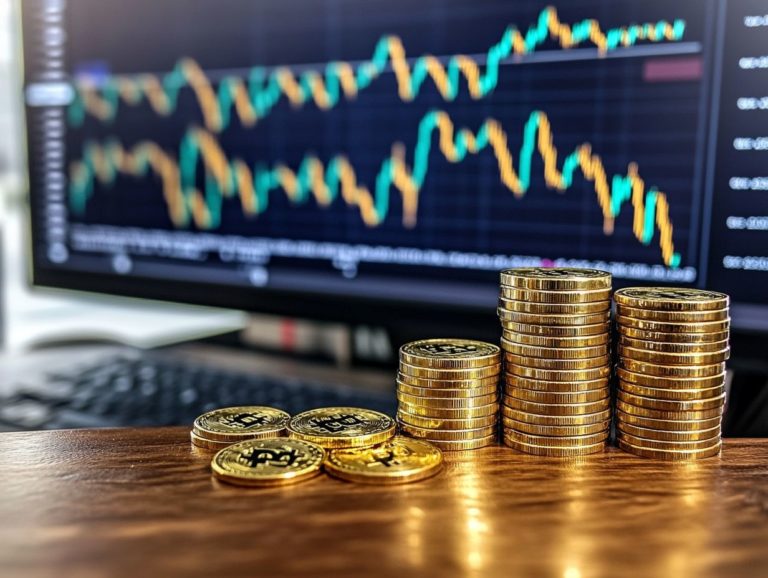The Psychology Behind Investing in Physical Assets
In a landscape where digital investments reign supreme, diversifying your portfolio with physical assets presents distinct advantages. These tangible assets grant you a sense of control and help mitigate impulsive decisions.
Understanding the emotional benefits is essential! Alongside practical elements such as market trends and long-term potential, it s important to grasp the psychological aspects of investing.
This article delves into the significance of physical assets, offers guidance on how to embark on this journey, and outlines strategies to maximize returns while minimizing risks.
Contents
- Key Takeaways:
- The Importance of Diversifying Your Investment Portfolio
- The Psychological Benefits of Investing in Physical Assets
- Factors to Consider When Choosing Physical Assets to Invest In
- How to Get Started with Investing in Physical Assets
- Maximizing Returns and Mitigating Risks
- Frequently Asked Questions
- What is the psychology behind investing in physical assets?
- Why do some individuals prefer investing in physical assets over other investment options?
- What are some common psychological biases that can influence investing in physical assets?
- How can emotions impact the decision to invest in physical assets?
- Are there any downsides to solely investing in physical assets?
- How can understanding the psychology behind investing in physical assets help investors make better decisions?
Key Takeaways:

- Diversifying your investment portfolio with physical assets can provide stability and protection against market volatility.
- Investing in physical assets provides a sense of tangible ownership and control, which reduces impulsive decisions.
- When selecting physical assets, think about market trends, demand, and their long-term return potential.
The Importance of Diversifying Your Investment Portfolio
Diversifying your investment portfolio is essential for managing risk and maximizing potential financial gains. By spreading your risk across various asset classes such as equities, bonds, and physical assets you can mitigate the effects of market fluctuations and psychological biases that might cloud your financial decisions.
Understanding behavioral finance, or the study of how emotions affect financial decisions, gives you the power to make more informed choices and steer clear of common investment pitfalls like being too sure of your investments and confirmation bias. This approach ultimately positions you for improved long-term outcomes, enhancing your overall investment strategy.
Why Physical Assets are a Valuable Addition
Physical assets like gold and silver can be your safe haven if you re looking to diversify your portfolio and hedge against market volatility.
These tangible investments have a track record of historical stability, making them particularly appealing during uncertain economic times. Consider the 2008 financial crisis, when gold prices soared over 25%, proving its ability to retain value while traditional stocks stumbled. Similarly, silver, often regarded as a more budget-friendly option, appreciated significantly, climbing nearly 50% from late 2008 to 2011.
As inflation concerns escalate, many investors like you are turning to physical assets, recognizing that their intrinsic value can serve as a buffer against currency devaluation. Statistically, these commodities have outperformed equities during various downturns, reinforcing their position as reliable financial safeguards. However, it’s crucial to be aware of the 5 common mistakes in physical asset investing to ensure you make informed decisions.
The Psychological Benefits of Investing in Physical Assets
Investing in physical assets provides you with a wealth of psychological advantages, enabling you to navigate emotional decision-making while fostering a sense of control over your financial future especially in the face of the inherent uncertainties of the stock market.
Sense of Tangibility and Control
The tangibility of physical assets offers you a unique sense of control, effectively alleviating the anxiety that often comes with volatile markets.
This feeling of control is rooted in behavioral finance, where owning tangible assets like gold and silver not only enhances your sense of security but also fosters a deeper connection to your investments. Unlike stocks or bonds, the physical presence of these metals can provide psychological comfort that reassures you during uncertain times. Their perceived intrinsic value often boosts your confidence in making financial decisions, as these assets tend to retain their worth, even amidst economic downturns. To understand more about the advantages of these investments, consider exploring the benefits of investing in physical metals.
This psychological bond can elevate your investment into a personal legacy, deepening your attachment and commitment in ways that transcend mere financial transactions.
Want to Make Smarter Investment Choices?
Investing in physical assets can help you avoid impulsive decisions. This approach anchors you in more stable, less emotionally driven choices compared to the unpredictable stock market.
When you shift your focus from volatile markets to tangible assets, you build a solid shield against common behavioral pitfalls. One such pitfall is the anchoring trap, where past reference points unduly influence your future decisions. For example, owning real estate or precious metals not only offers a sense of security but also embodies intrinsic value, as explored in the psychology of gold investments. This helps you weather the emotional highs and lows that often accompany investing.
Behavioral finance highlights the necessity of a disciplined approach. Cultivating a mindset focused on long-term goals rather than fleeting whims increases your chances of navigating the turbulent waters of market sentiment. For those curious about the differences in investment types, exploring 5 FAQs about physical vs. paper assets can provide valuable insights.
Factors to Consider When Choosing Physical Assets to Invest In
When choosing physical assets for investment, consider several key factors. Look closely at current market trends, assess the long-term potential of each asset, and evaluate how they align with your overall investment strategies.
This thoughtful approach will help you maximize your financial gains.
Market Trends and Demand
Understanding market trends and demand is essential for making informed decisions when investing in physical assets like gold and silver.
The fluctuations in global economic conditions, coupled with various geopolitical events, significantly influence the appetite for these tangible investments. As an investor, you assess economic indicators like inflation rates and employment statistics to gauge market sentiment and predict future asset performance. Understanding the pros and cons of physical assets can also aid in making informed decisions.
Unexpected global events, such as trade disputes or natural disasters, can swiftly shift your investment priorities. This underscores the need for adaptive strategies. Align your investment strategy with current trends to boost your financial returns.
Long-Term Potential
Evaluating the long-term potential of physical assets is crucial for achieving stable financial gains in your portfolio.
By focusing on the durability and future prospects of these investments, you can navigate market fluctuations more effectively. Take real estate, for example; it has historically demonstrated remarkable resilience, often appreciating in value over decades even during temporary economic downturns. Commodities like gold have consistently served as a hedge against inflation, and understanding the benefits of owning physical precious metals can further enhance your investment strategy.
This reinforces the idea that physical assets can offer both security and growth. Adopting a long-term perspective enhances your investment strategy while fostering psychological benefits. Steady investments can reduce the anxiety tied to market unpredictability, empowering you to cultivate a more tranquil mindset and instill confidence in your financial decisions. It’s also important to be aware of the risks of investing in paper assets to make informed choices.
How to Get Started with Investing in Physical Assets
Embarking on the journey of investing in physical assets requires a thorough approach. Engaging in comprehensive research, performing due diligence, and crafting meticulous financial plans are essential steps.
By doing so, you ensure your investments align with your overarching financial goals and resonate with your individual risk tolerance. Don’t miss out on securing your financial future today!
Research and Due Diligence

Conduct thorough research and due diligence. This step is fundamental in your investment journey, especially with physical assets.
Equip yourself with the right techniques to navigate this complex landscape. Use resources like industry reports, economic data, and asset valuations to uncover insights that guide your decisions.
Don t hesitate to seek expert opinions from industry professionals. Their insights enhance your understanding and reveal small details that might not be immediately apparent. It s crucial to grasp the specific characteristics of various physical assets, such as real estate or equipment, as these factors heavily influence valuation and long-term viability.
Each asset type presents its own unique risks and opportunities. This makes it essential to adopt a tailored approach to research and evaluation.
Financial Planning and Budgeting
Effective financial planning and budgeting are game-changers! Ensure your investments in physical assets align with your goals.
Start with a detailed budget outlining your income and expenses. Consider how assets like real estate and collectibles fit into your strategy.
By evaluating the potential return on each investment and aligning it with both your short-term liquidity needs and long-term aspirations, you can navigate the complexities of asset management more effectively. For instance, considering strategies to protect physical investments can enhance your strategic alignment. This not only fosters a sense of security but also gives you the power to make informed decisions in your pursuit of everyday financial health and future prosperity.
Maximizing Returns and Mitigating Risks
Your goal should be to maximize returns and reduce risks. This is crucial with physical assets, where psychological biases can impact decision-making.
Strategies for Successful Physical Asset Investment
Developing successful investment strategies for physical assets demands a keen understanding of market dynamics, potential risks, and the potential for financial gains.
Consider adopting a diversified approach within this asset class. Break your investments into various categories such as real estate, commodities, and collectibles to mitigate risks associated with any single asset and capitalize on diverse market opportunities.
Employing effective methods to minimize losses and maximize gains, like setting clear investment goals and regularly reviewing your portfolio’s performance, can significantly enhance your overall returns. By continually educating yourself on market trends and adjusting your strategies accordingly, you’ll be better equipped to navigate the complexities of investing in physical assets, utilizing 5 investment strategies for physical assets to ultimately foster more sustainable financial growth.
Frequently Asked Questions
What is the psychology behind investing in physical assets?

The psychology behind investing in physical assets is rooted in the human desire for security and tangible ownership. People often view physical assets, such as real estate or precious metals, as a safe and reliable way to preserve and grow their wealth.
Why do some individuals prefer investing in physical assets over other investment options?
Some individuals prefer investing in physical assets because it allows them to have a tangible and visible representation of their wealth. This can provide a sense of security and control over their investments, as opposed to intangible assets like stocks or bonds.
What are some common psychological biases that can influence investing in physical assets?
Common psychological biases influence investing in physical assets. For example, the endowment effect makes people overvalue assets they own.
Loss aversion bias makes individuals more sensitive to potential losses than to potential gains.
How can emotions impact the decision to invest in physical assets?
Emotions like fear and greed play a significant role in investment decisions. Fear can drive a desire for security, leading individuals to invest in physical assets to protect against losses.
Greed may spark a longing for quick profits, causing investors to overlook the risks involved.
Are there any downsides to solely investing in physical assets?
There are downsides to investing only in physical assets. Lack of diversification can be a risk, along with illiquidity and high transaction costs.
Illiquidity means the difficulty of selling an asset quickly without losing value.
Consider these factors to maintain a well-rounded investment portfolio.
How can understanding the psychology behind investing in physical assets help investors make better decisions?
Understanding the psychology behind investing can help you recognize and overcome biases. This knowledge leads to better decision-making and a balanced approach to investing.
Avoid impulsive and emotional choices for more strategic planning!















